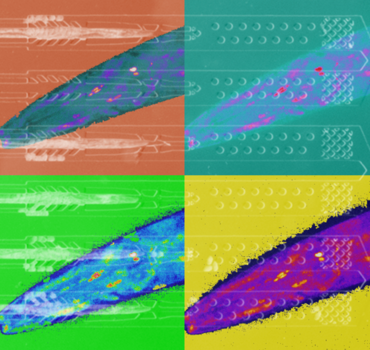Perception of oxidative stress signals in the nematode C. elegans
Reactive oxygen derivatives are both messengers and poisons in cells: at physiological doses, they activate numerous signaling pathways; at excessive doses, they cause oxidative stress, a threat to the integrity of cellular constituents. In this study by the Charvin team, with Sophie Quintin as first author, and published in the journal PLOS One, the scientists decipher the mechanisms of oxidative stress perception in the nematode C. elegans. They show that the animal perceives light and hydrogen peroxide (H2O2) differently by neurons in the head and tail, via distinct molecular mechanisms.

Under normal conditions, reactive oxygen derivatives serve as catalysts in many signaling pathways. However, during a stress caused by exposure to a physical or chemical agent (UV rays, toxin, pesticide,...), their intracellular concentration becomes excessive, and they constitute a threat for DNA, proteins or lipids. This is called oxidative stress. This is involved in many diseases such as cancer, diabetes or atherosclerosis. In response to oxidative stress, cells deploy an antioxidant arsenal, which has been the subject of numerous studies. However, how stress signals, such as H2O2, one of the reactive oxygen derivatives, are perceived and integrated at the level of an entire organism remains largely unknown.
The nematode C. elegans, a very simple model organism, was chosen to study this question. The challenge for the researchers was to decipher the neuronal activity of animals exposed to different doses of H2O2, sometimes mimicking an oxidative stress, sometimes a physiological dose. In order to address this challenge, they pooled their respective skills in cell biology and biophysics, allowing them to analyze in real time the neuronal responses of animals immobilized on a microfluidic chip (see illustration). Their work shows that the response to H2O2 involves neurons of the head, called I2, and of the tail, called PHA, which do not present the same sensitivity to H2O2. The response of I2 and PHA neurons relies on distinct molecular mechanisms, the common denominator of which is the requirement for peroxiredoxin, a highly conserved antioxidant. Finally, while it has long been known that nematodes had a flight reflex when a flash of light was applied to their tails, this study shows for the first time that PHA neurons are light-sensitive cells, acting as rudimentary eyes.
Thus, this work illustrates that in both nematodes and yeast, light and H2O2 perception are closely related, but that the signal transduction mechanisms are different in head and tail neurons. The researchers hypothesize that the integration of signals from these neurons guides the worm's behavioral response to exogenous stress and allows it to find an adapted niche in its environment.
